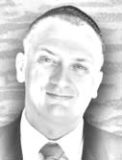With a technology like point-of-care ultrasound (POCUS), there are two options for how to develop this technology and spread it in the community. Either you bring technology and have people use it, or you realise that the value of technology by itself is very limited without augmenting it by providing education.
I use the example of the stethoscope, invented by René Laennec. When he invented it, some people argued that it would never gain any traction—it’s cumbersome, requires quite a bit of training and so on. What Laennec understood was that if you want the stethoscope technology adopted by the community, you have to provide education with the technology. He’s very well known not only for the stethoscope, but also because he wrote the first treatise on medical auscultation (Laennec 1819). He paired the invention of the technology with education, and that’s what made the technology successful.
What we did in our study on POCUS was demonstrate how you can implement curricula to teach residents how to use the technology and how this education changes the way residents practise medicine (Ramsingh et al. 2015). Technology itself is not going to change the way people practise medicine. Technology paired with education has more impact.
Maxime Cannesson, MD, PhD, is Professor of Anesthesiology and Vice Chair for Perioperative Medicine at UCLA. He is the Technology, Computing, and Simulation section editor forAnesthesia & Analgesia. His research interests focus on new technologies applied to anaesthesia and the intensive care unit.
I use the example of the stethoscope, invented by René Laennec. When he invented it, some people argued that it would never gain any traction—it’s cumbersome, requires quite a bit of training and so on. What Laennec understood was that if you want the stethoscope technology adopted by the community, you have to provide education with the technology. He’s very well known not only for the stethoscope, but also because he wrote the first treatise on medical auscultation (Laennec 1819). He paired the invention of the technology with education, and that’s what made the technology successful.
What we did in our study on POCUS was demonstrate how you can implement curricula to teach residents how to use the technology and how this education changes the way residents practise medicine (Ramsingh et al. 2015). Technology itself is not going to change the way people practise medicine. Technology paired with education has more impact.
Maxime Cannesson, MD, PhD, is Professor of Anesthesiology and Vice Chair for Perioperative Medicine at UCLA. He is the Technology, Computing, and Simulation section editor forAnesthesia & Analgesia. His research interests focus on new technologies applied to anaesthesia and the intensive care unit.
What are your key areas of interest and research?
Mostly new technology development. I like to get excited with something, and usually this comes from things in the beginning that nobody believes in—my radar gets turned on…What are the major challenges in your field?
The main challenge is to try to understand what the value of anaesthesiology is in a world moving to value-based care. How do we define the value of anaesthesiologists, and the value of technology we are using in our field? These go hand in hand—it’s the main equation.What is your top management tip?
Trust.What would you single out as a career highlight?
Each time one of my students graduates and becomes a physician.If you had not chosen this career path you would have become a…?
Nurse.What are your personal interests outside of work?
Food, wine and friends.Your favourite quote?
“The future is already here, it is just unevenly distributed” (William Gibson)References:
Laennec, René (1819). De l'auscultation médiate ou traité du diagnostic des maladies des poumon et du coeur. Paris: Brosson & Chaudé.
Ramsingh D, Rinehart J, Kain Z et al. (2015) Impact assessment of perioperative point-of-care ultrasound training on anesthesiology residents. Anesthesiology, 123(3): 670-82.
Ramsingh D, Rinehart J, Kain Z et al. (2015) Impact assessment of perioperative point-of-care ultrasound training on anesthesiology residents. Anesthesiology, 123(3): 670-82.























